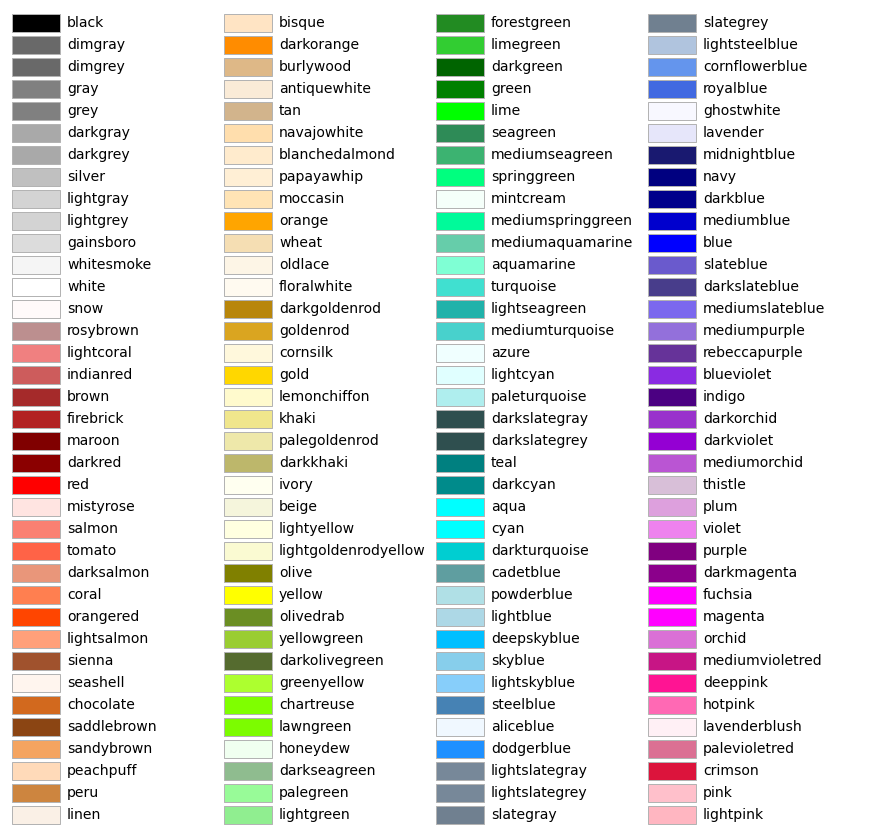There are a lot of libraries about colors in python and there are several ways to apply color to our plots: RGB, tuples and we can even color by names (matplotlib) but I like the xcolor a LaTeX package. By this package we can apply color using expressions like green!40!yellow. What means this? the final color is a mixture between green and yellow with a 40% of green and 60% of yellow. Expressions like blue!70!red!20 is also allowed and means that the final color is a mixture between blue and red with a 70% of blue and 30% of red and also the value 20 at the end of the expression means that we will give the color 20% transparency.
In addition, it allows to calculate the complementary color following the equations:
Let r, g, and b be RGB components of the original colora and let rc, gc, and bc be RGB components of the complementary color.
Then:
rc = max(r,g,b) + min(r,g,b) - r
gc = max(r,g,b) + min(r,g,b) - g
bc = max(r,g,b) + min(r,g,b) - b
This is great for me and it is a very nice way to create new colors.
For this reason I have created the namecolor_to_rgb function, to translate this expressions to a list and this list can be applied as color in Python.
Only is mandatory load the to_rgb function from matplotlib.colors. This is necessary to translate the color names to rgb. You also need the np.max and np.min functions from the numpy package.
The list of color names in matplotlib is the following.
From matplotlib.colors can be loaded the dictionary mcolors.CSS4_COLORS. This is a dictionary with pairs color name and definition.
Color theory and the color wheel
Matplotlib Colors
Creating color maps with matplotlib
import matplotlib.pyplot as plt
import numpy as np
The function is very simple and translate from string to list of four numbers (from 0 to 1) that matplotlib understands as a color.
from matplotlib.colors import to_rgb
def namecolor_to_rgb(s, complementary = False):
colors_ = s.split('!')
color1_ = to_rgb(colors_[0])
color2_ = to_rgb(colors_[2])
proportion = int(colors_[1])
final_color = [0.0, 0.0, 0.0, 1.0]
for i_ in range(3):
final_color[i_] = color1_[i_] * proportion/100 + color2_[i_] * (100 - proportion)/100
if len(colors_) == 4:
final_color[3] = int(colors_[3])/100
if complementary:
rc = np.max(final_color[:3]) + np.min(final_color[:3]) - final_color[0]
gc = np.max(final_color[:3]) + np.min(final_color[:3]) - final_color[1]
bc = np.max(final_color[:3]) + np.min(final_color[:3]) - final_color[2]
final_color[0] = rc
final_color[1] = gc
final_color[2] = bc
return final_color
If with calling the function with three arguments, this is, without alpha argument.
namecolor_to_rgb('yellow!80!white')
[1.0, 1.0, 0.2, 1.0]
If we calling the function with alpha argument, this is, the alpha argument.
namecolor_to_rgb('yellow!80!white!50')
[1.0, 1.0, 0.2, 0.5]
data_ = [10, 20, 10, 5]
plt.bar(x = [1,2,3,4],
height = data_,
color = namecolor_to_rgb('yellow!50!white'))
plt.show()
data_ = [10, 20, 10, 5]
plt.bar(x = [1,2,3,4],
height = data_,
color = namecolor_to_rgb('yellow!60!green'))
plt.show()
data_ = [10, 20, 10, 5]
plt.bar(x = [1,2,3,4],
height = data_,
color = [namecolor_to_rgb('yellow!70!white'),
namecolor_to_rgb('yellow!70!white'),
namecolor_to_rgb('yellow!70!white', complementary = True),
namecolor_to_rgb('yellow!70!white', complementary = True),])
plt.show()
data_ = [10, 20, 10, 5]
plt.bar(x = [1,2,3,4],
height = data_,
color = [namecolor_to_rgb('green!70!white'),
namecolor_to_rgb('lightgreen!70!white'),
namecolor_to_rgb('green!70!white', complementary = True),
namecolor_to_rgb('lightgreen!70!white', complementary = True),])
plt.show()
From light to color.
data_ = [10, 20, 10, 5, 10, 12, 8, 6, 12]
plt.bar(x = [1,2,3,4,5,6,7,8,9],
height = data_,
color = [namecolor_to_rgb('yellow!10!white'),
namecolor_to_rgb('yellow!20!white'),
namecolor_to_rgb('yellow!30!white'),
namecolor_to_rgb('yellow!40!white'),
namecolor_to_rgb('yellow!50!white'),
namecolor_to_rgb('yellow!60!white'),
namecolor_to_rgb('yellow!70!white'),
namecolor_to_rgb('yellow!80!white'),
namecolor_to_rgb('yellow!90!white'),])
plt.show()
data_ = [10, 20, 10, 5, 10, 12, 8, 6, 12]
plt.bar(x = [1,2,3,4,5,6,7,8,9],
height = data_,
color = [namecolor_to_rgb('darkred!10!white'),
namecolor_to_rgb('darkred!20!white'),
namecolor_to_rgb('darkred!30!white'),
namecolor_to_rgb('darkred!40!white'),
namecolor_to_rgb('darkred!50!white'),
namecolor_to_rgb('darkred!60!white'),
namecolor_to_rgb('darkred!70!white'),
namecolor_to_rgb('darkred!80!white'),
namecolor_to_rgb('darkred!90!white'),])
plt.show()
From black to color.
data_ = [10, 20, 10, 5, 10, 12, 8, 6, 12]
plt.bar(x = [1,2,3,4,5,6,7,8,9],
height = data_,
color = [namecolor_to_rgb('yellow!10!black'),
namecolor_to_rgb('yellow!20!black'),
namecolor_to_rgb('yellow!30!black'),
namecolor_to_rgb('yellow!40!black'),
namecolor_to_rgb('yellow!50!black'),
namecolor_to_rgb('yellow!60!black'),
namecolor_to_rgb('yellow!70!black'),
namecolor_to_rgb('yellow!80!black'),
namecolor_to_rgb('yellow!90!black'),])
plt.show()
Gradient between two colors.
data_ = [10, 20, 10, 5, 10, 12, 8, 6, 12]
plt.bar(x = [1,2,3,4,5,6,7,8,9],
height = data_,
color = [namecolor_to_rgb('darkred!10!deepskyblue'),
namecolor_to_rgb('darkred!20!deepskyblue'),
namecolor_to_rgb('darkred!30!deepskyblue'),
namecolor_to_rgb('darkred!40!deepskyblue'),
namecolor_to_rgb('darkred!50!deepskyblue'),
namecolor_to_rgb('darkred!60!deepskyblue'),
namecolor_to_rgb('darkred!70!deepskyblue'),
namecolor_to_rgb('darkred!80!deepskyblue'),
namecolor_to_rgb('darkred!90!deepskyblue'),])
plt.show()
Gradient between two colors using list comprehensions.
colores = ['darkred!' + str(x) + '!deepskyblue' for x in [10,20,30,40,50,60,70,80,90]]
data_ = [10, 20, 10, 5, 10, 12, 8, 6, 12]
plt.bar(x = [1,2,3,4,5,6,7,8,9],
height = data_,
color = list(map(namecolor_to_rgb, colores)))
plt.show()
colores = ['darkred!50!deepskyblue!' + str(x) for x in [10,20,30,40,50,60,70,80,90]]
data_ = [10, 20, 10, 5, 10, 12, 8, 6, 12]
plt.bar(x = [1,2,3,4,5,6,7,8,9],
height = data_,
color = list(map(namecolor_to_rgb, colores)))
plt.show()
colores = ['darkred!70!deepskyblue!' + str(x) for x in [10,20,30,40,50,60,70,80,90]]
data_ = [10, 20, 10, 5, 10, 12, 8, 6, 12]
plt.bar(x = [1,2,3,4,5,6,7,8,9],
height = data_,
color = list(map(namecolor_to_rgb, colores)))
plt.show()
data_ = np.repeat(10,100)
colores = ['darkorange!' + str(x) + '!dodgerblue' for x in range(100)]
plt.bar(x = range(100), height = data_, width = 1.0,
color = list(map(namecolor_to_rgb, colores)))
plt.show()
data_ = np.repeat(10,100)
colores = ['purple!' + str(x) + '!olivedrab' for x in range(100)]
plt.bar(x = range(100), height = data_, width = 1.0,
color = list(map(namecolor_to_rgb, colores)))
plt.show()
import matplotlib.colors as mcolors
list_of_colors = list(mcolors.CSS4_COLORS.keys())
colors_to_plot_ = []
for i_ in range(20):
color1_ = np.random.choice(list_of_colors, size = 1)[0]
color2_ = np.random.choice(list_of_colors, size = 1)[0]
mix_ = np.random.randint(low = 0, high = 99, size = 1)[0]
colors_to_plot_.append(color1_ + '!' + str(mix_) + '!' + color2_)
colors_to_plot_
['lightgray!58!royalblue',
'ivory!54!peachpuff',
'seagreen!47!papayawhip',
'darkviolet!47!dodgerblue',
'gold!42!royalblue',
'gainsboro!18!khaki',
'orange!86!moccasin',
'skyblue!30!darkgreen',
'powderblue!93!linen',
'darkmagenta!92!magenta',
'salmon!81!blueviolet',
'lightgoldenrodyellow!33!magenta',
'turquoise!91!salmon',
'brown!87!magenta',
'darkslategray!0!purple',
'firebrick!25!darksalmon',
'lemonchiffon!80!brown',
'coral!4!olivedrab',
'blueviolet!15!palevioletred',
'palegreen!21!darkgray']
data_ = [10, 15, 10, 5, 10, 12, 8, 6, 12, 5, 8, 9, 8, 5, 8, 3, 9, 7, 12, 13]
plt.bar(x = [1,2,3,4,5,6,7,8,9,10,11,12,13,14,15,16,17,18,19,20],
height = data_,
color = list(map(namecolor_to_rgb, colors_to_plot_)))
plt.show()














